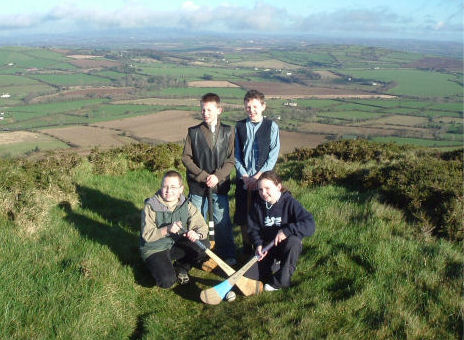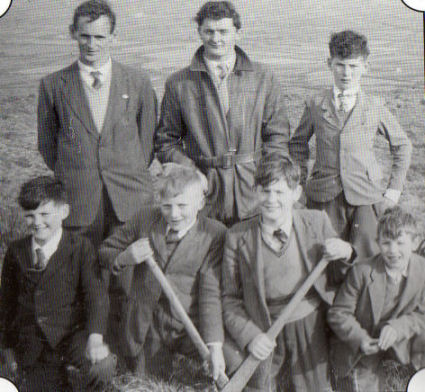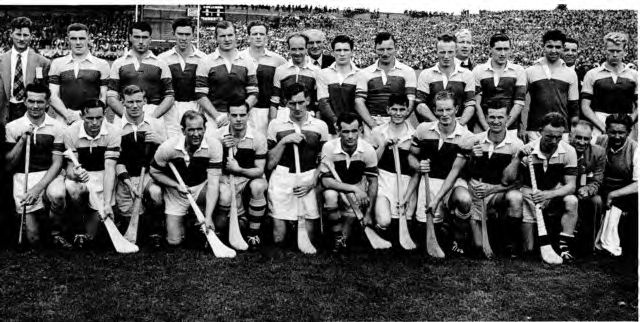| |
Local
History
|
Our
hurling heritage
|

Laurence,Nicola,
Tomás and Micheál on top of Sliabh Coillte.
Feb.5th 2005
|
The following is an
extract from the Folklore of Co.Wexford collected
by Bridget Nash of Nash,Cassagh,a pupil in
Gusserane NS in 1938. She collected it from Martin
Doyle of the same address. It shows that hurling
was played in Horeswood before the GAA was started
in 1884. There was a famous hurling green near the
summit of Sliabh Coillte around the year 1880.
There was no road to the viewing point back then
and both players and spectators had to climb to
the playing green.
'Long ago hurling matches were
played on top of Slieve Coillte mountain, the
nearest mountain to where I live. All townlands
and parish matches were finished there. The top of
the mountain is level and at each end of the
playground they used have a long thin sally with
both ends stuck down in the ground. It took the
shape of a loop and when the ball passed through
it, it was counted a score. At each side of the
loop there was a man to see if the ball went
through and when it did he raised a green flag.
All lookers-on would know it was a score. There
was also a referee out among the players. Hurleys
were made of ash in different shapes and sizes to
suit the players. The local carpenters made them.
The number of men in each team was seventeen. A
match often lasted two and a half hours. The
players wore nothing only a shirt and trousers and
they wore nothing on their feet. The hurling balls
were all made by shoemakers. This type of game
died out in most of Ireland in the nineteenth century
due mainly to the landlords' loss of interest.
Long ago football and hurling were
played in a different way to what they are played
to-day. Instead of playing from goal to goal as
they do nowadays they played from ditch to ditch.
Thirty years ago one of the roughest matches of
the day was played in Foulksmills between a team
from Taghmon and another from Campile. The match
which lasted for two and a half hours was supposed to be the roughest ever played in the
district. They fought and hurt each other until
there was only two men left on the field, Campile
taking the victory by four "overs" to
three'.
|

|
|
Hurling on Sliabh Coillte
around 1958:
Back: Paddy Grennan, Dick Crosbie, Noel
Culleton.
Front: Ray Culleton,Bill Murphy, Tommy
Grennan, Michael Murphy.
|
Another story concerns an
incident which occurred in the 1880's. On
one occasion a local team was fixed to play
a Cork team. The landlord in the Ballykelly
area at the time was a Captain Gifford and a
native of Cork. Jimmy Quinn was the star
player on the local team and Gifford
dispatched him on foot to Dublin with a
letter the day before the game. Jimmy
managed to make the return trip, much to the
surprise Captain Gifford, and to help his
team beat their Cork opponents.
|
|
The Rev. Thomas Handcock,Church of Ireland
Rector for Whitechurch and Kilmokea,wrote in
1816 about the people of the present day
Horeswood parish: "The
lower classes are uncommonly fond of dancing
and the young men of ball playing: for these
amusements they assemble in multitudes in
the evenings of Sundays and Holydays and no
instance of disorder has ever known to occur
on these occasions" |
|
Two
Hurling Greats from Horeswood |
 |
This
is a picture of the Wexford All Ireland
hurling team from 1955 and has two Horeswood
men on it.
Back row left to right: K.Sheehan
(trainer), P.Kehoe, J.Morrissey, M.Codd,
N.Rackard, T. Ryan, T.Bolger, O.Gough,
W.Wickham, M.Hanlon, T.Dixon,
H.O'Connor, E.Wheeler. Front row (left
to right): T.Flood, B.Rackard, J.English,
P.Kehoe, M Morrissey, N. O'Donnell (capt.) A
Foley, C.Casey, W.Rackard, D. Hearne,
S.Bluett, P.Hayes.
|
|
Mick O'Hanlon won two All Ireland medals in
1955 and 56 and four Leinster medals.
Dominic Hearne won an All Ireland medal in
1955 and three Leinster medals. |
|
Please
return to Local History |
|
|
|
|
|
|
|

